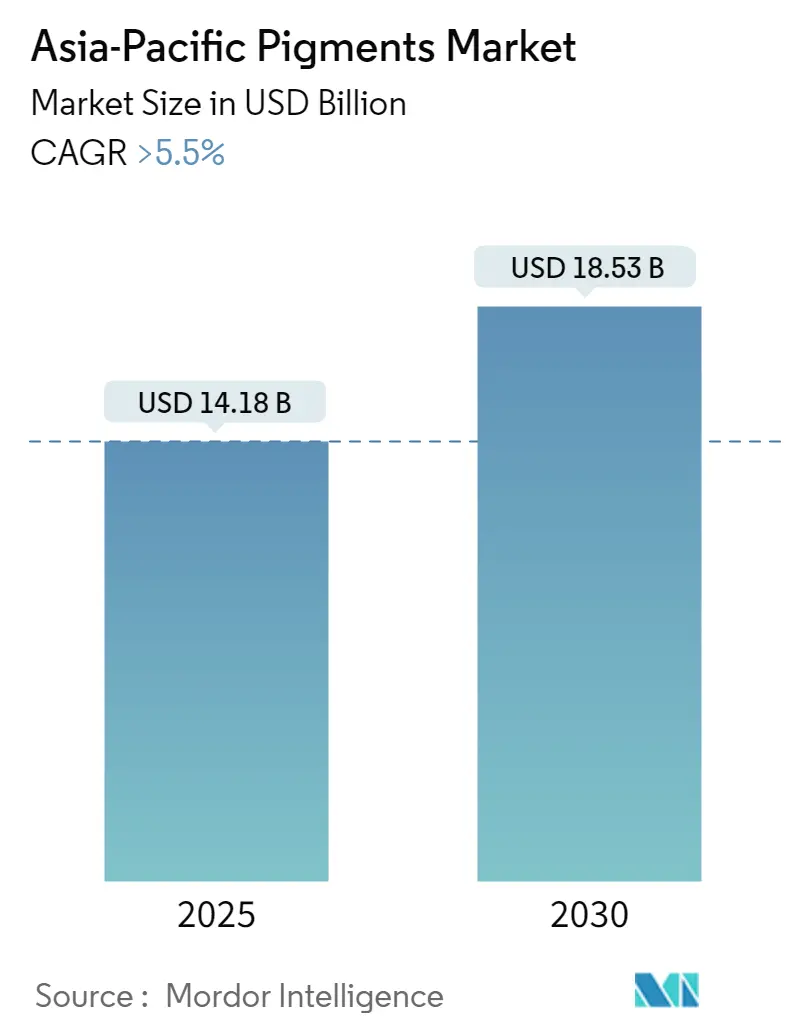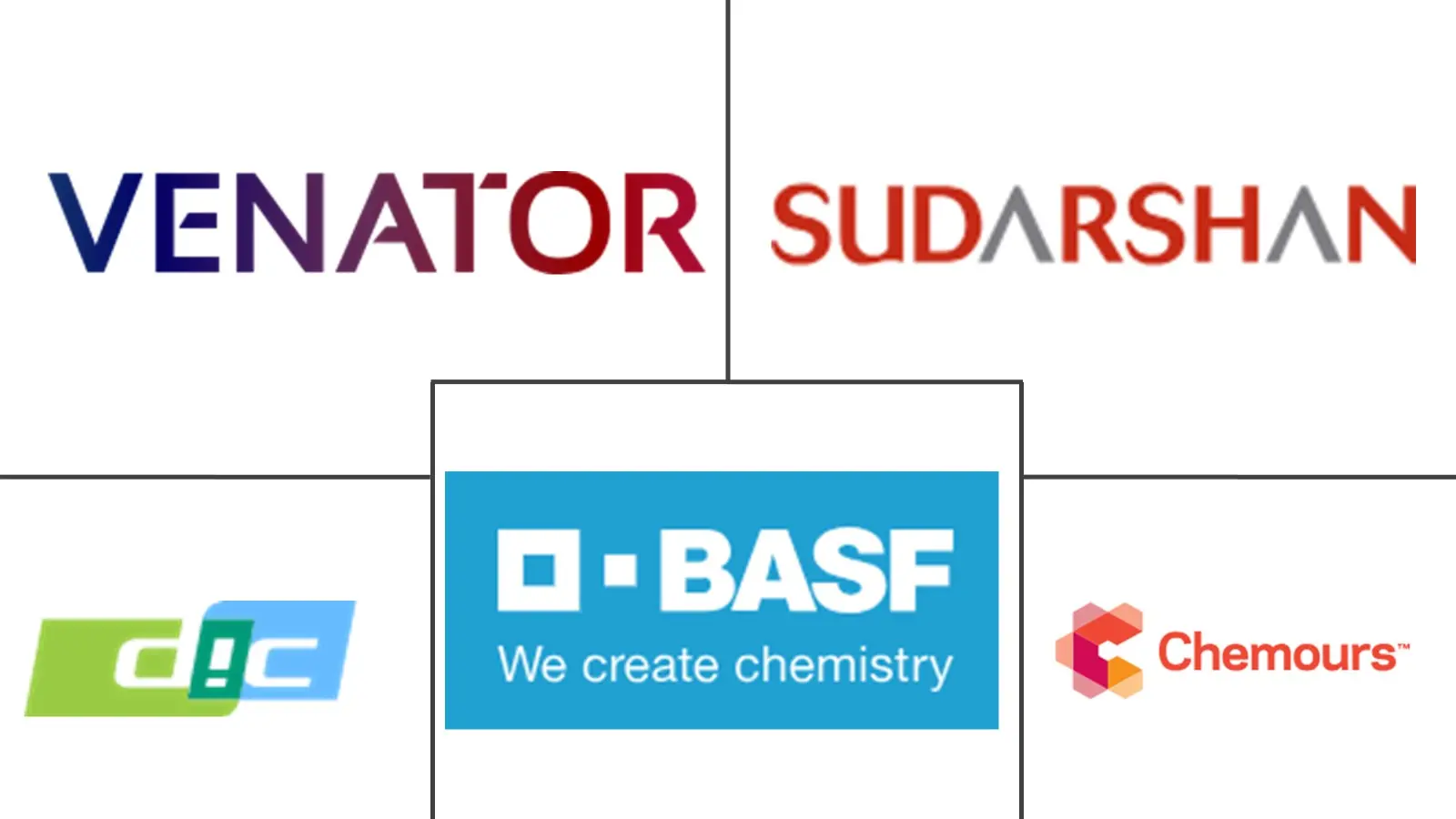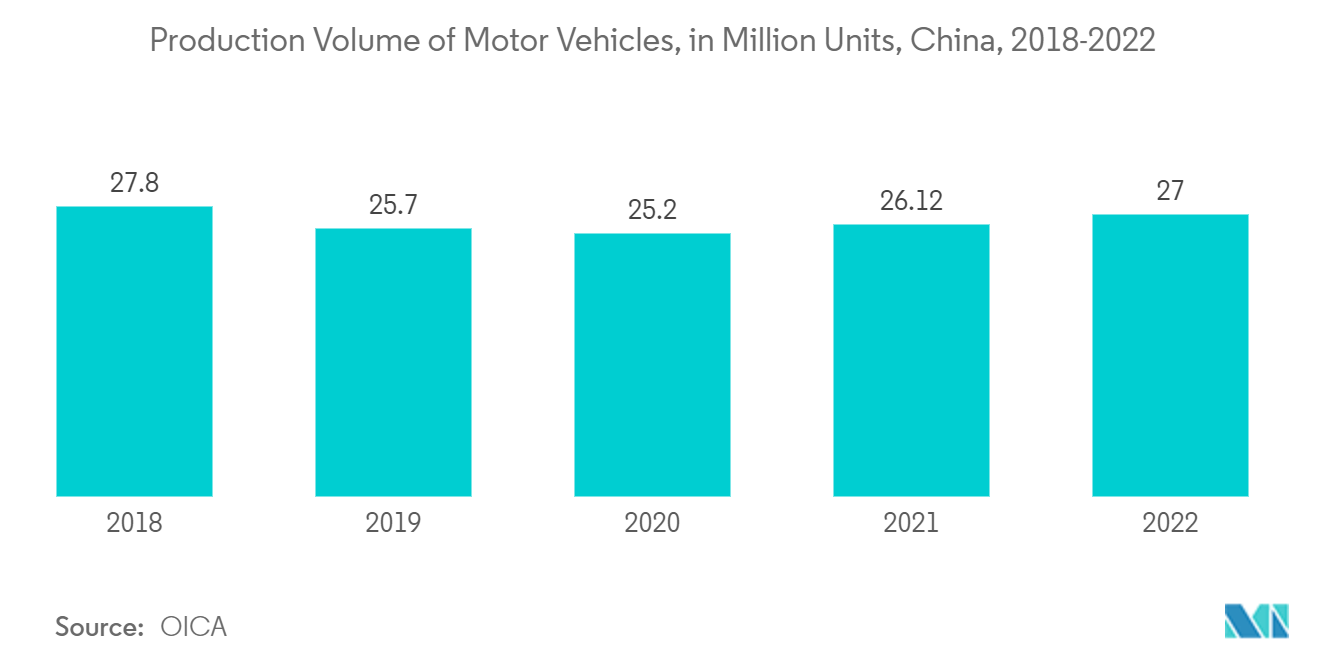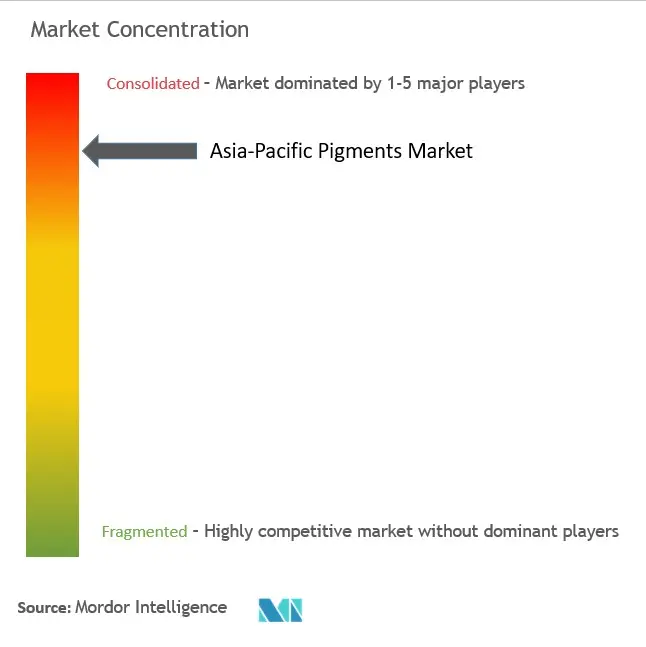
Asia Pacific Pigments Market Analysis
The Asia-Pacific Pigments Market size is estimated at USD 14.18 billion in 2025, and is expected to reach USD 18.53 billion by 2030, at a CAGR of greater than 5.5% during the forecast period (2025-2030).
- The Asia-Pacific pigments market was negatively affected by the COVID-19 pandemic. Countries like China, Japan, and India were worst hit by the COVID-19 pandemic in the region. The COVID pandemic resulted in lockdowns in these countries, thereby affecting the paints and coatings, textiles, and printing inks, thus affecting the pigment market. However, the market recovered well after the restrictions were lifted. Recently, the market registered a significant growth rate due to rising demand for pigments in paints and coatings and textile applications.
- The growing demand from the paints and coatings industry, increasing demand from the textile industry, and the increasing demand for pigments from plastics applications are expected to drive the market.
- The stringent government regulations on the usage of pigments are expected to hinder market growth.
- The shifting focus toward eco-friendly products is expected to create opportunities for the market during the forecast period.
- China is expected to dominate the market due to the rising demand for pigments in paints, coatings, and textiles applications. It is also expected to register the highest CAGR during the forecast period.
Asia Pacific Pigments Market Trends
Increasing Demand from the Paints and Coatings Industry
- Pigments are majorly used in paints and coatings production. These are engineered, enabling them to withstand challenging demands without compromising the coating performance. China, India, and South Korea are the largest markets for paints and coatings in the region. The demand for paints and coatings is increasing in the construction and automotive industries in the region.
- China is the largest automotive vehicle manufacturer in the region. According to OICA (The Organisation Internationale des Constructeurs d'Automobiles), automotive vehicle production in China reached a total of 27.02 million units in 2022, an increase of 3% over the previous year for the same period.
- India has become the second-largest automotive vehicle manufacturer in the region. According to OICA, the total production volume of automotive vehicles reached 5.45 million units in 2022, indicating a growth of 24% as compared to 4.39 million units registered in 2021. Thus, the increase in the production of automotive vehicles is expected to drive the demand for automotive coatings, thereby driving the market for pigments.
- The Indian government has been actively boosting housing construction to provide houses to about 1.3 billion people. The country is likely to witness around USD 1.3 trillion of investment in housing over the next seven years, including the construction of 60 million new houses in the country. The availability of affordable housing in the country is expected to increase by around 70% by 2024.
- Similarly, in South Korea, the demand for paints and coatings is increasing from the automotive industries. In 2022, the production of automotive vehicles in the country reached 3.75 million, registering a year-on-year growth rate of 9% from 3.46 million units manufactured in the previous year. The increase in the production volume of automotive vehicles is likely to drive the market for automotive coatings.
- The government also outlined its plan to execute large-scale redevelopment projects aimed at supplying 830,000 housing units in Seoul and other cities of the country by 2025. From the planned construction, Seoul will be getting 323,000 new houses, and 293,000 houses will be built near Gyeonggi Province and Incheon. Significant cities like Busan, Daegu, and Daejeon will also be benefitting with 220,000 new houses in 4 years. Thus, the rising number of construction activities is expected to drive the demand for paints and coatings.
- Thus, the growth of the paints and coatings industry is expected to drive the region's pigments market.
China is Expected to Dominate the Market in the Asia-Pacific Region
- China is one of the significant markets for pigments in the Asia-Pacific region. Pigments are used in various applications, such as paints, coatings, textiles, leather, printing inks, and plastics. In the construction industry, architectural and decorative coatings account for the enormous consumption of pigments in their production.
- China is one of the largest construction markets in the Asia-Pacific region. According to the National Bureau of Statistics of China, the output value of construction works in the country accounted for CNY 31.2 trillion (USD 4.34 trillion) in 2022, as compared to CNY 29.31 trillion (USD 4.084 trillion) in 2021. Additionally, demand is increased for residences that are used as investment properties. China is expected to spend nearly USD 13 trillion on buildings by 2030, creating a positive market outlook for the pigments market.
- Moreover, the automobile industry in the country is witnessing switching trends as the consumer inclination toward battery-operated vehicles is on the higher side. Furthermore, the Chinese government estimates a 20% penetration rate of electric vehicle production by 2025. This is reflected in the electric vehicle sales trend in the country, which went to a record-breaking high in 2022. As per the China Passenger Car Association, the government sold 5.67 million EVs and plug-ins in 2022, touching almost double the sales figures achieved in 2021.
- In China, the textile industry registered significant market growth. According to the National Bureau of Statistics of China, textile production volume accounted for 38.2 billion meters in 2022, compared to 23.5 billion meters during the same period in the previous year.
- In 2022, China was the top-ranked global textile exporter, with a value of approximately USD 148 billion. Similarly, the European Union ranked in second place, with an export value of around USD 71 billion. The export value of textiles is further expected to increase in the coming years, thereby driving the current studied market.
- The plastics industry in China has witnessed increased production outputs over the years due to the growing demand for engineering plastics in high-end industries like automotive assembly and electronic manufacturing. There are over 15,000 plastic manufacturing companies in the country.
- Therefore, the growth in the market for paints and coatings, plastics, and textiles in China is also likely to drive the market for pigments in the country.
Asia Pacific Pigments Industry Overview
The Asia-Pacific pigments market is consolidated in nature. Some of the key players in the market (not in any particular order) include BASF SE, DIC Corporation, Sudarshan Chemical Industries Limited, The Chemours Company, and Venator Materials PLC.
Asia Pacific Pigments Market Leaders
-
BASF SE
-
The Chemours Company
-
Venator Materials PLC
-
Sudarshan Chemical Industries Limited
-
DIC Corporation
- *Disclaimer: Major Players sorted in no particular order
Asia Pacific Pigments Market News
- November 2022: Cathay Industries declared the successful acquisition of Venator Materials PLC's iron oxide pigment business. This strategic move is expected to facilitate the expansion of Cathay Industries' global manufacturing presence.
- January 2022: Clariant finalized the sale of its pigments business to a consortium comprising Heubach Group and SK Capital Partner. Following the transaction, Clariant retained a 20% stake in the new holding company, contributing approximately USD 131.6 million. This joint ownership structure includes Heubach, SK Capital, and Clariant in the new venture.
Asia Pacific Pigments Industry Segmentation
Pigments are molecules or substances that absorb specific wavelengths of visible light to produce a particular hue. Pigments can be found in paintings, inks, cosmetics, and other items. Pigments are found in various products and services associated with coloring materials and related technology. Pigments are used in various sectors, including coatings, plastics, printing inks, building, paper, leather, and cosmetics. Organic and inorganic pigments are available, with organic pigments being the most commonly used.
The market is segmented by product type, application, and geography. The market is segmented by product type into inorganic (titanium dioxide, zinc oxide, and other inorganic product types such as iron oxide, chromium oxide, etc.), organic, specialty pigments, and other product types like metallic pigments, natural pigments, etc. By application, the market is segmented into paints and coatings, textiles, printing inks, plastics, leather, and other applications such as cosmetics, ceramics, electronics, etc. The report also covers the market size and forecasts for the Asia-Pacific pigments market for five major countries.
For each segment, the market sizing and forecasts are based on value (USD).
| Product Type | Inorganic | Titanium Dioxide |
| Zinc Oxide | ||
| Other Inorganic Product Types (Iron Oxide, Chromium Oxide, etc.) | ||
| Organic | ||
| Specialty Pigments | ||
| Other Product Types (Metallic Pigments, Natural Pigments, etc.) | ||
| Application | Paints and Coatings | |
| Textiles | ||
| Printing Inks | ||
| Plastics | ||
| Leather | ||
| Other Applications (Cosmetics, Ceramics, Electronics, etc.) | ||
| Geography | China | |
| India | ||
| Japan | ||
| South Korea | ||
| Australia & New Zealand | ||
| Rest of Asia-Pacific |
Asia Pacific Pigments Market Research FAQs
How big is the Asia-Pacific Pigments Market?
The Asia-Pacific Pigments Market size is expected to reach USD 14.18 billion in 2025 and grow at a CAGR of greater than 5.5% to reach USD 18.53 billion by 2030.
What is the current Asia-Pacific Pigments Market size?
In 2025, the Asia-Pacific Pigments Market size is expected to reach USD 14.18 billion.
Who are the key players in Asia-Pacific Pigments Market?
BASF SE, The Chemours Company, Venator Materials PLC, Sudarshan Chemical Industries Limited and DIC Corporation are the major companies operating in the Asia-Pacific Pigments Market.
What years does this Asia-Pacific Pigments Market cover, and what was the market size in 2024?
In 2024, the Asia-Pacific Pigments Market size was estimated at USD 13.40 billion. The report covers the Asia-Pacific Pigments Market historical market size for years: 2019, 2020, 2021, 2022, 2023 and 2024. The report also forecasts the Asia-Pacific Pigments Market size for years: 2025, 2026, 2027, 2028, 2029 and 2030.
Our Best Selling Reports
Asia Pacific Pigments Industry Report
Statistics for the 2025 Asia-Pacific Pigments market share, size and revenue growth rate, created by Mordor Intelligence™ Industry Reports. Asia-Pacific Pigments analysis includes a market forecast outlook for 2025 to 2030 and historical overview. Get a sample of this industry analysis as a free report PDF download.






